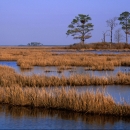About Us
Susquehanna National Wildlife Refuge, also known locally as Battery Island, is located at the mouth of the Susquehanna River in Harford County, Maryland.
Our Mission
The mission of the National Wildlife Refuge System is "to administer a national network of lands and waters for the conservation, management, and where appropriate, restoration of the fish, wildlife, and plant resources and their habitats within the United States for the benefit of present and future generations of Americans.” —Refuge Improvement Act; Public Law 105-57
Our History
In the early 1940's, the Battery Island and over 13,000 acres of water were closed to hunting migratory waterfowl by presidential order and designated as the Susquehanna National Wildlife Refuge.
The refuge and surrounding areas were once covered with wild celery, pond weeds, redhead grass and other desirable waterfowl food sources. At their peak, waterfowl included over 500,000 canvasback and redhead ducks as well as over 200,000 American wigeon. These rich areas of aquatic growth began declining in the 1960's due to changes in the water quality and quantity. Development above the Conowingo Dam caused more rapid drainage and greater water flow through the dam. Currents in the upper Chesapeake Bay deposited heavy loads of silt in the Susquehanna flats area. The remaining waterfowl vegetation was destroyed by Hurricane Agnes in 1972. Only a few thousand geese remained around the refuge during winter.
Due to the sharp decrease in waterfowl population and vegetation in the area, the presidential proclamations which originally closed the water areas were lifted on September 1, 1978, and returned to Maryland for supervision. Battery Island remained a part of the National Wildlife Refuge System.
The island had been severely eroded by winds and waves, and until recently was less than one acre in size. However, the planned maintenance dredging of the Susquehanna River near Havre de Grace, Maryland, by the U.S. Army Corps of Engineers provided an opportunity to restore high-quality nesting and brood rearing habitat for black ducks and other waterbirds. The island has been built up using 200,000 cubic yards of clean dredged material which is being used to create approximately 11 acres of upland habitat in a horseshoe shape around and including the existing island.
Other Facilities in this Complex
Susquehanna NWR is a part of the Chesapeake Marshlands NWR Complex.
